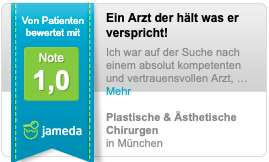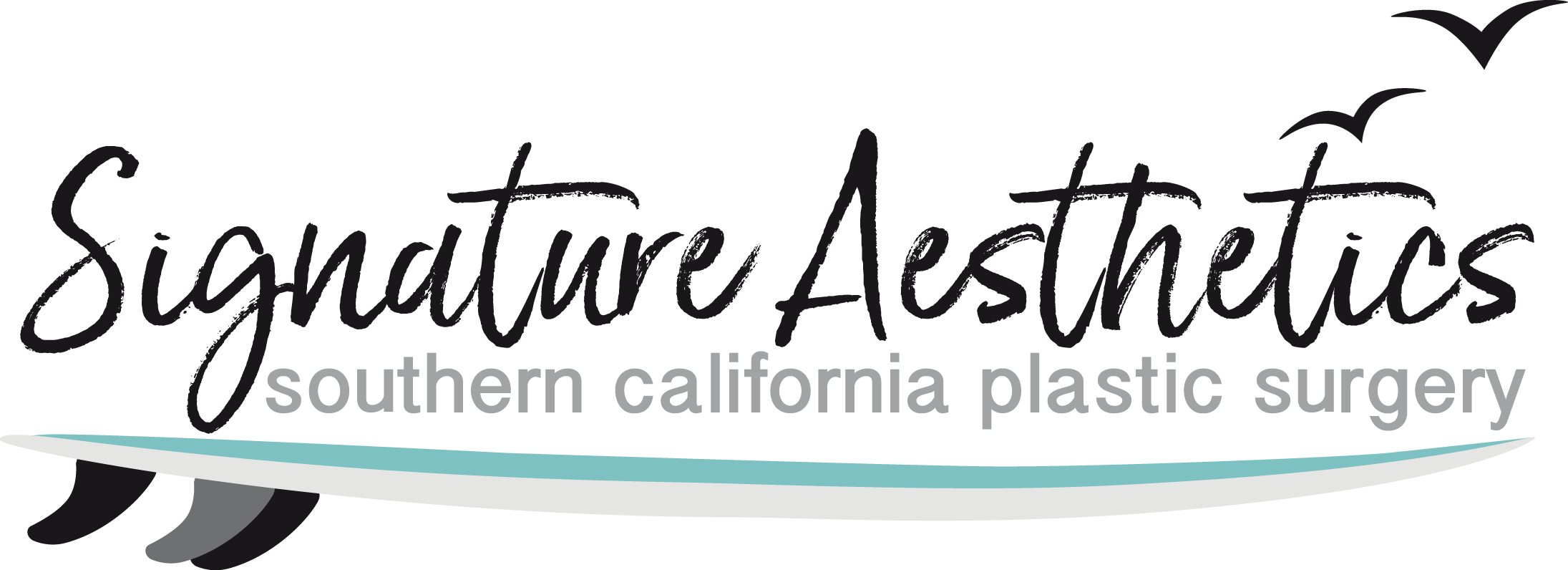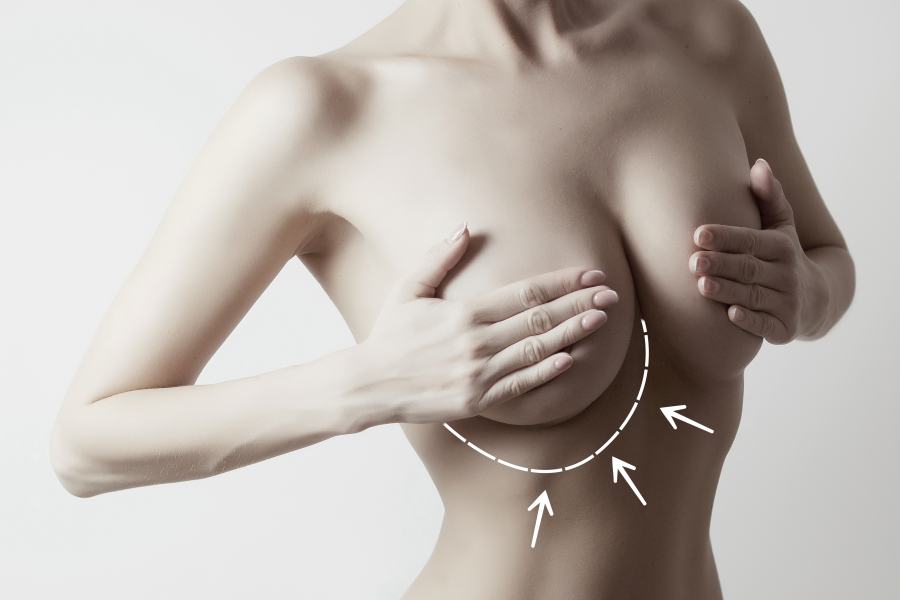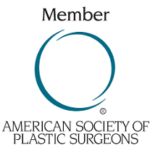Breast augmentation
Breast augmentation specialist Dr. Scholz can boast flawless reviews for this plastic surgery. Excellent knowledge and techniques for modeling a perfect breast combined with the experience gained in Southern California, USA.
In order to achieve excellent long-term results in breast surgery, it is very important to understand what a well-shaped breast looks like from an aesthetic point of view.
While the surgical techniques of breast augmentation and breast surgery in general can be taught during plastic surgery training, Dr. Scholz believes that the understanding and feeling for a beautiful and attractive breast cannot be learned.
Contents
Click on one of the following topics.
- Introduction
- Experience
- Procedure of the surgery
- Costs
- Methods
- Healing
- Side effects
- Questions and answers
- Breast implants
- Pregnancy

Introduction
Breast augmentation does not mean that a surgical incision is made somewhere, a pocket is dissected out, a breast implant is placed in it and then everything is closed up. The breast implant is merely a tool.
It allows me as a plastic surgeon to add volume to the patient’s breast. The most important component of breast augmentation is the plastic and three-dimensional shaping of the soft tissue of the breast and mammary gland around the breast implant.
This extremely creative process gives the breast a completely new shape, which has become necessary due to the increased volume. Simply adding volume to a good-looking natural breast with the help of an implant, without the time-consuming process of individual shaping, will never end in an aesthetically excellent long-term result for the patient.
Apart from the fact that the breast with its new volume must be completely reshaped creatively around the implant, all individual asymmetries and irregularities must be addressed.
I will be happy to personally show you options that will not only help you look fantastic but also feel fantastic.
Experience
In Dr. Scholz’s experience, the contours of an attractive breast are largely a matter of personal and cultural preference. This means that women basically have very different ideas, perceptions, wishes and expectations regarding the result of how their breasts should look.
Dr. Thomas Scholz: It is therefore essential that a plastic surgeon has both a natural talent and an aesthetic eye that has been trained over many years in order to be able to recognize the individual differences, asymmetries, contour deviations and functional requirements of a female breast.
Every woman faces these challenges before an operation. It is therefore extremely important that a plastic surgeon understands the wishes of their patients so that they can work together towards a precisely defined aesthetic goal.
For this reason, it is very important to Dr. Scholz to devote an above-average amount of time to his patients in the run-up to an operation and surgical planning.
Procedure of the surgery
A detailed initial consultation takes place in Munich in our private practice. Here you will get to know the surgeon, the facilities and the entire team that will treat and care for you. In a state-of-the-art environment and equipped with unique and state-of-the-art technical facilities, we will explain everything you need to know before breast augmentation, everything you are interested in and everything you have always wanted to know about this surgical procedure.
The operation usually takes between one and two hours and is performed under general anesthesia.
No drainage
Dr. Scholz has not used drains in his breast augmentations for over 10 years. Drains were previously used to collect wound fluid after an operation. Unfortunately, these drains, which are very uncomfortable for the patient, are still a common procedure in many cases.
The operation begins with small incisions in the natural crease under the breast, in the armpits or on the underside of the nipples. A trial implant is then inserted through the opening under the breast tissue and pectoral muscle to ensure a natural shape.
Then, as described above, the breast is shaped around the implant and all asymmetries and contour deviations are addressed. Only when the perfectly shaped breast form has been achieved is the incision (also known as the surgical approach) finally closed with self-dissolving surgical suture material.
After the operation, you will receive individual and very personal care until it is guaranteed that you have tolerated the operation well. Not least due to the fact that I do not use drains, there is no need to stay overnight in our clinic after the operation.
Where are the cuts?
In breast augmentation, there are basically three ways to make the incisions. All approaches are designed in such a way that visible scars are largely avoided.
- Axillary incision: Surgical access is via the armpits.
- Inframammary incision: The most frequently chosen approach is in the inframammary fold.
- Periareolar incision: A well-placed incision around the nipple, at the transition from pigmented to non-pigmented skin
All three of these incisions (surgical approaches) are basically sensible decisions from a plastic surgery perspective. However, each incision has its own advantages and disadvantages, all of which will be discussed with you in detail during the surgical planning.
How are the implants inserted?
The implants are placed either submuscularly under the pectoral muscle or subglandularly under the breast tissue, but above the pectoral muscle. Submuscular means that the implants are placed under the breast tissue and pectoral muscle, while subglandular means that the implant is placed between the breast tissue and pectoral muscle.
Submuscular placement is particularly recommended for women with weak subcutaneous connective tissue and breast tissue. Subglandular implants are more visible and easier to palpate and also lead to capsular fibrosis more frequently than submuscular implants.
Aftercare
A high level of aftercare is crucial to the success of any surgical procedure. After the operation, you will only have contact with qualified nursing staff in the clinic. Before you leave the clinic, you will be given a full post-operative consultation, as well as a telephone number to call 24 hours a day if you have any questions or concerns.
Follow-up examinations are then carried out in the private practice of Dr. Thomas Scholz himself. We do everything we can to ensure that you as a patient make a quick and full recovery. We are there for you at all times. This gives you the security and peace of mind you need for an optimal healing process.
Costs – Prices
We agree the costs with you personally according to your requirements and wishes. You will find that Dr. Scholz takes a lot of time for you as a patient during the entire treatment. The treatment concept and the cost estimate are based on this.
Please note that an apparent bargain can mean catastrophic risks for your body. It is better to get a perfect result that you are proud of and a specialist who will look after you long after the breast surgery.
The cost estimate is influenced by
- Outpatient or inpatient stay
- Anesthesia
- Breast augmentation method
- Autologous fat
- Breast implants
- Quality of medical aids (implants, autologous fat processing)
- Expertise and experience Dr. Scholz
- Special requirements or indications
Today, apparently low prices abroad such as the Czech Republic, Poland and Turkey are an issue. Without evaluating the medical services there, you have clear advantages at the Munich location.
- Specialist with control of the medical chambers
- Follow-up care even after 1 year
- Intensive support
- Excellent clinical standards
- Central location and connections
- Legal certainty and German standards
- 24-hour emergency call / assistance
Financing
With the help of the cost estimate, you can arrange payment in installments or financing with a service provider. Talk to us about this personally.
In a few justified cases, the costs may be covered by health insurance, but this must first be clarified on the basis of medical indications. Without a confirmed assumption of costs by a health insurance company, you must bear the costs yourself.
Methods
There are two methods of breast augmentation: the well-known implants and breast surgery with autologous fat (also known as lipotransfer).
Methods with implants
There are many different types of implants, each available in different shapes and sizes. Only first-class brand implants are used in our clinic:
Polytech (D)
Allergan Natrelle (USA)
Mentor (USA)
Round and teardrop-shaped implants can be selected depending on the wishes and objectives of the operation.
These companies have been leaders in the manufacture of implants since the 1960s. The implants are filled with silicone gel, although implants filled with saline solution are also available.
The physique and breast shape of the woman mainly determine which implants can deliver the best results in each individual case.
It is extremely important that we work together to find the best breast implants for you. This process requires careful information and an intensive exchange of ideas between doctor and patient.
Method with autologous fat
Breast augmentation using autologous fat is an alternative to silicone or saline implants. The advantage of the autologous fat method – also known as lipofilling – is that no foreign material such as silicone is implanted into the body and therefore rejection reactions or capsular fibrosis are ruled out.
The body’s own fat is removed from unwanted fat deposits on the stomach, hips or thighs using a cannula (similar to liposuction). One advantage is that autologous fat also gives a much more natural feel (haptics).
One disadvantage of this method is that only moderate breast augmentation can be achieved.
Healing process
Sport
As the implant still has to settle into position, you should avoid sport – apart from walks in the fresh air – during the first month. Light exercises can be started after 2 to 4 weeks. It is important to take it easy on the chest and upper body area and to avoid sweating until the incisions have completely healed. Abrupt movements lead to traction on the implants and sweat has a negative effect on wound healing.
In addition, heavy lifting (> 5 KG) should be avoided for a minimum of 6 – 8 weeks.
Sports such as tennis, jogging or horse riding should only be resumed after 6 weeks to 3 months (with a special bra). As rehabilitation can vary greatly from person to person, we have prepared regular follow-up checks for you. When sports and other activities can be resumed should always be discussed individually with the surgeon during this follow-up examination.

Sleeping
However, you can sleep on your back or on your side immediately after the operation. If possible, it is advisable to sleep with your upper body raised (30-45°) for the first 1-2 weeks.
Body care
A full body shower is possible 3 – 4 days after the operation. You can also lift your arms above your shoulders immediately after the operation, which enables you to wash your hair, apply make-up, etc. independently.
Bra after breast surgery
As the implants first have to settle into their new position, it is necessary to wear a special bra, similar to a sports bra, day and night for at least 6-8 weeks. This bra protects and supports the breasts and holds the implants in the correct position until they have fitted into the body.
Scars after breast augmentation?
Many women ask Dr. Scholz about breast augmentation scars. As the surgical incisions are made in very discreet places in the armpits or in the natural folds of the breasts, scarring is minimal and usually almost invisible.
The scars fade over time until only wafer-thin lines are visible, which are barely noticeable. People who are prone to excessive scarring (keloids) should discuss this with their surgeon.
There are treatment options that can be used prophylactically before an operation. In addition, these patients require special attention during the postoperative period to ensure appropriate scar care and scar treatment to prevent the formation of wide scars or excessive scarring.
How long will it take for me to fully recover?
After the operation it is necessary to wear a special, supportive post-operative bra 24 hours a day. This looks a bit like a sports bra and is designed to support and protect your new breasts during the healing process.
As every patient is different, recovery times vary, but we generally expect a full recovery and return to all normal activities around six to eight weeks after surgery. Most people return to work one to two weeks after the procedure.
Behavior after the operation
- State-of-the-art surgical techniques lead to a quick and easy recovery.
- To support the implants, you will need to wear a special bra – affectionately known as a “granny bra” – day and night for 6 weeks.
- The surgical wound must not get wet in the first few days, so the full bath or shower should be replaced by a sponge bath. Carrying weights and one-sided strain should be strictly avoided.
- Sunbathing should be avoided until the scar has completely healed. This can last a whole year or more.
- Continuous management and care of the scars is also beneficial afterwards.
Are there any long-term precautions after breast augmentation?
No. The only precautions you need to take are the same ones you took before your operation. Breast implants are surrounded by many myths. Flying, for example. But none of them have a real basis.
Side effects
In addition to the risk of anesthesia, which exists with every operation, other short-term risks include secondary bleeding or infections. The occurrence is extremely rare, but to be on the safe side, regular follow-up checks should be carried out by the plastic surgeon.
The media is full of reports about the risks and side effects of silicone implants. Scientific studies take the basis of these sensational reports. Implants do not pose a risk of breast cancer, nor has a connection with rheumatism been established. Modern implants are safe in every respect.
One of the most unpleasant side effects is capsular fibrosis. Hardening of the body’s own tissue surrounding the implants. As a defense against the foreign body implant, the body produces a hard collagen shell.
Depending on the individual constitution, capsular fibrosis now only occurs in around 1% of all breast augmentations.
Pain after breast augmentation
The sensation of pain is a completely individual variable. While sensitive women complain of pain, less sensitive women can easily cope with the pain. However, as this is a surgical procedure, post-operative pain and soreness must be controlled with medication. Nowadays, there are a variety of very intelligent pain medications that allow a quick return to normal daily activities.
What does capsular contraction or capsular fibrosis mean?
After breast augmentation, the body usually encapsulates the implant with a thin layer of healthy tissue, as it cannot reject this foreign body.
This layer of natural breast tissue is called the capsule and is a natural and healthy part of the healing process. Capsular contraction occurs when the formation of the capsule (consisting of scar tissue and collagen) is excessive, leads to thickening and presses on the breast implant over time.
A few years ago, the risk was still 3-5%. Modern surgical techniques targeting the development of capsular fibrosis have been very effective in reducing this complication of capsular contracture. If redness, inflammation or pain occurs, you should contact our clinic immediately.
Questions and answers
When does breast augmentation make sense?
There are many reasons for breast augmentation, which vary from woman to woman.
The most common reasons for having this operation are small breasts, asymmetrical breasts, or breasts that have lost volume and/or shape due to weight loss or pregnancy.
There are no right or wrong reasons to undergo breast surgery. It is essential for all patients to research the subject in detail, send inquiries to trustworthy clinics and talk to me in detail.
Why do women want breast augmentation?
- Increasing self-confidence
- Underlining your own femininity
- Look perfect at work and at home
- Finally being able to wear the clothes, underwear and swimwear you’ve always wanted to wear
- Changes in the size, shape, position and/or firmness of the breasts after pregnancy, weight loss or due to the natural ageing process
- The desire for symmetrical breasts
- Desire for a curvier overall appearance
Breast augmentation vs breast augmentation with breast lift
In order to achieve an optimal result, it is determined during the consultation and examination whether a pure breast augmentation can be performed or whether a lift (breast lift) should also be recommended during the operation. After breastfeeding, with pronounced sagging breasts or after major weight loss, it is usually unavoidable to remove excess tissue and skin during breast augmentation in the course of a breast lift in order to achieve an optimal aesthetic long-term result.
From what age?
Breast augmentation is not recommended for women who are not yet fully developed, as the body and breast shape can still change. At the clinic, we only operate on patients who are over 18 years old and in good general health.
Because your cosmetic surgeon has access to your medical records, they will be able to tell you whether or not the procedure is suitable for you. All patients, regardless of age, undergo a health assessment.
How do I choose the right cup size?
Deciding on the right size takes up a large part of your surgical consultation. The size that leads to your personal ideal result depends on your current breast size, breast shape, your physique and your ribcage, among other factors.
Breast implants
We only use globally recognized EU-certified (CE standard) implants of the highest quality.
Polytech implants are manufactured in Germany.
Allergan (Natrelle) implants (formerly McGhan) are manufactured in the USA.
Mentor implants are manufactured in the USA.
How long do breast implants last?
Bear in mind that breast implants are usually guaranteed for 10 and 15 years. Whether the implants should be replaced afterwards must always be discussed individually between you and your plastic surgeon.
Round or anatomical (dimensionally stable) implants
The purpose of the pre-operative consultation(s) is for the surgeon to work with you to draw up a surgical plan and a customized treatment plan for you. As part of these preparations, it is also determined whether round or anatomical implants are to be used.
Round implants are used in around 96% of cases. It is fundamentally wrong that anatomical implants achieve a natural result and round implants an unnatural or artificial result.
Whether a breast looks natural or artificial after a breast augmentation only has something to do with how the operation was technically performed by the surgeon. Both a round and an anatomical (teardrop-shaped, form-stable) breast implant can have a natural or unnatural, artificial-looking result.
With anatomical implants, unwanted rotation also occurs – rarely.
Pregnancy
After childbirth, breastfeeding and happiness, women often have a rude awakening when they realize that their breasts are suddenly no longer as firm and full as they were before. More and more women do not want to accept this situation and are looking for help in creams and gymnastics.
If these do not achieve the desired results, women are increasingly opting for breast surgery after pregnancy. After pregnancy, the aesthetic requirements for the breast shape vary greatly from patient to patient.
A certain breast firming effect can already be achieved with breast augmentation.

Breast augmentation after pregnancy
Is it possible to breastfeed with breast implants?
Yes, absolutely. It is advisable to tell the plastic surgeon if you plan to have children and are breastfeeding. This is an important topic that should be discussed in detail.
Conclusion
For you as a patient, it is important to realize that in this aesthetic operation, the enlargement of the breast is not achieved simply by inserting an implant. The specialist must have a basic aesthetic sense and be able to model your breasts beautifully so that you have a result that looks natural and feminine.
Technical terms
Subglandular: Placement under the mammary gland above the pectoral muscle
Breast augmentation: breast enlargement
Capsular fibrosis: foreign body reaction
Lipotransfer: transplantation of the body’s own fat cells
Drainage: drainage of fluid
Dr. Scholz Munich
- Plastic, Aesthetic, and Reconstructive Surgeon, University of California, USA
- German specialist in plastic and aesthetic surgery
- Swiss specialist certification for plastic and aesthetic surgery
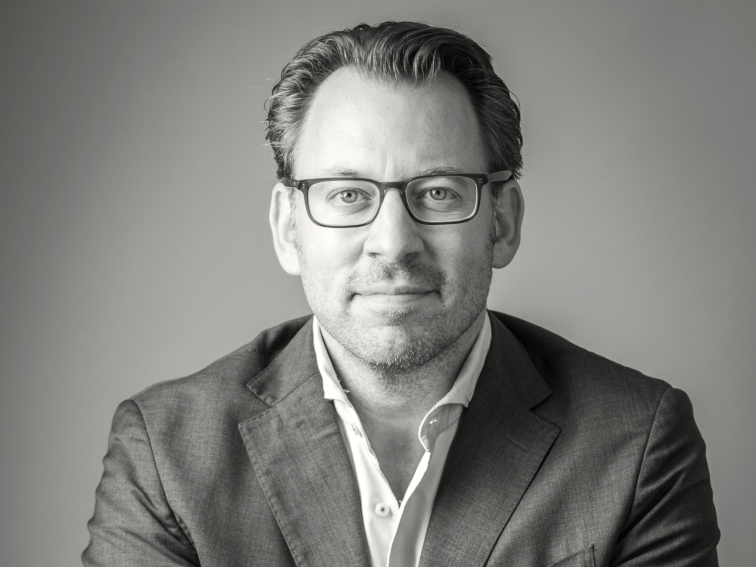
Picture credits © Christof Arnold
Reviews
Read our reviews on Jameda or here on our website and the internal quality management system
